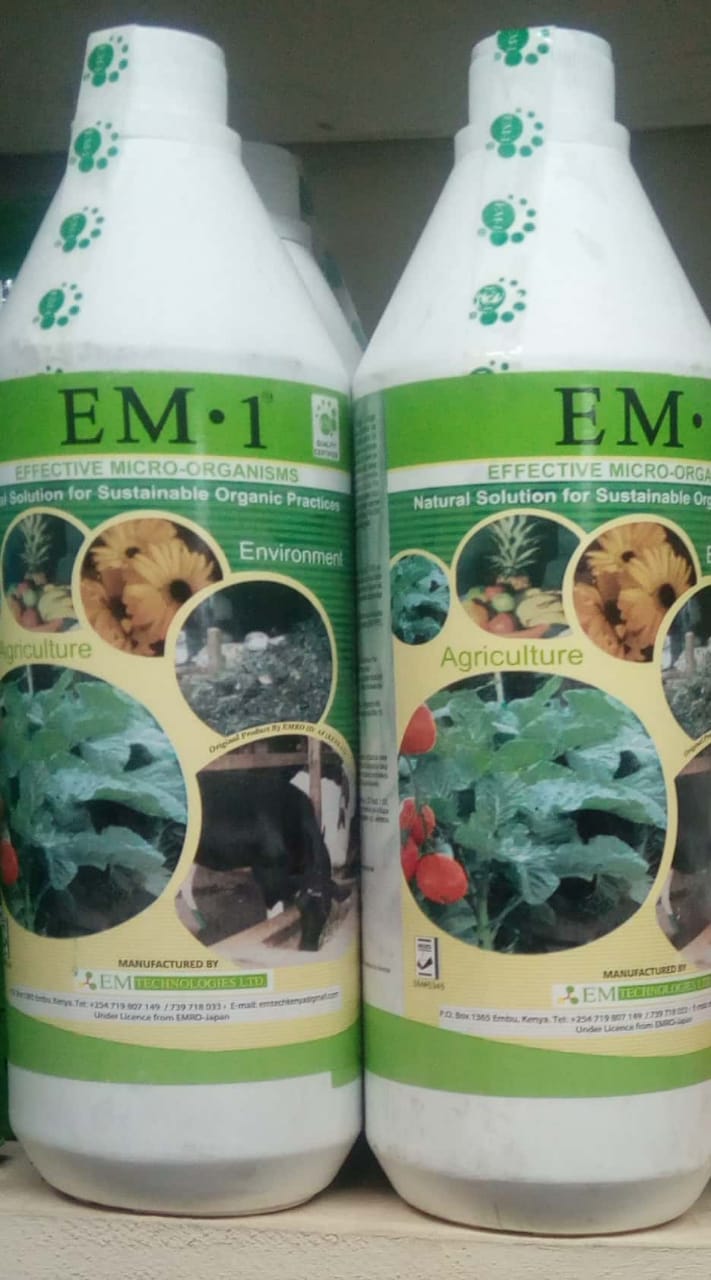
By George Munene
Rita Nangira, a mixed farmer at Mureko, Kakamega County has improved plant growth by over 30 per cent using effective microorganisms (EM) and effective microorganism activated solution (EMAS). EM is affordable to farmers with one liter of costing just Sh350-375 in agrovets and capable of being utilised on 30 hectares of farmland. EMAS is even cheaper as a liter of EM1 can be multiplied into 20 liters.
“I have been using EMAS for six months now after being introduced to it by a neighbor farmer and becoming better conversant with its formulation from my own research. It has enhanced the performance of fertiliser I apply while also suppressing soil-borne diseases which have almost halved my application of pesticides,” says the 38-year-old who grows horticultural produce and fruits on her 4.5-acre farm.
Effective microorganisms technology (EM) was developed in Japan by agriculture scientist at the University of Ryukyus and uses safe and human-friendly microorganisms. It is now in use in over 140 countries in the world to supplement growing media with beneficial microorganisms that stimulate composting, suppress harmful microbes and improve the response of fertiliser as well as restoring the quality of water.
Related News: Farmer increases eggs 60% with homemade azolla plant protein
Related News: FarmBiz TV:Biochar organic fertilizer gives 50% to 70% yield increase
EM is a mixed-culture solution of effective microbes that works to get natural processes to function more effectively by stimulating biological activity in the soil and plant. EM also serves as a microbial or soil inoculant—agricultural amendments that use microbes to promote plant health. It is yellow to brown in color with a sweet-sour fermented smell and has a PH value of 4 and below.
Effective microorganism activated solution (EMAS) is an activated EM solution formulated to trigger and multiply the beneficial microbes in EM1 which exists in a stagnant state.. It is intuitive—easy to understand and use as well as able to heal the soil and environment organically.
“To make EMAS which is anaerobically fermented (without air) I use a clean plastic container that is tightly covered and stored in a cool dry place away from direct sunlight with an ideal temperature range of 20-35°C. To make one liter of EMASS it is recommended you use 90 per cent, 900 milliliters of unchlorinated water (chlorinated water kills both harmful and beneficial bacteria); five percent, 50ml of EM1 (use genuine EM1 sourced from reliable distributors) and another five percent, 50ml of clean molasses. My EMAS mixture is usually fermented after five days to one week; if temperatures are low you will need extra days for it to ‘ripen’. I open the lead to my solution at least once a day to release gas that forms 2-3 days after mixing. On day seven once fermentation is complete there will be no gas. The mixture is usually dark to light brown and gives off a sweet-sour smell with no odor,” explains Rita.
Related News: Proper planting for over 10 tonnes from acre of sweet potatoes
Related News: Yara fertiliser program increases maize yield two-fold
The microbial activity in EMAS is higher within the first month and dissipates gradually after that. EMAS is applied as 10m (one tablespoon) in one liter of water and is sprayed directly on leaves once or twice a week. The best time for application is between 5 am-9 am in the morning or in the afternoon between 3 pm-6 pm. This is the ideal spraying time plant stomata is opening up and ready to absorb available microbes. EMAS solution can also be directly applied to the soil. Mixed in with water at 10ml of EMAS for a liter the mix can also be used as a probiotic to bolster the immune systems of animals such as chickens, pigs and rabbits. Once it is mixed with water, EMAS, especially if fed to animals should be used within 24 hours to avoid contamination.
The main microbes present in EM1 are lactic acid bacteria, yeast and phototrophic bacteria. Lactic acid bacteria decompose organic matter by fermentation and acts as a barrier that keeps off harmful microbes by lowering PH inhibiting the growth of pathogens. Yeast for its part decomposes organic matter through fermentation and produces bioactive substances that are converted into plant food. Yeast also improves the immune systems of animals and plants. Phototropic bacteria neutralises pungent smell by decomposing harmful gases such as ammonia and hydrogen sulfide changing them into odorless gases.
















Comments powered by CComment